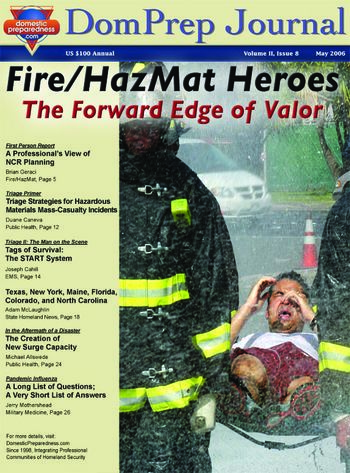

A Long List of Questions; A Very Short List of Answers
Jerry Mothershead
May 24, 2006
The administration’s development and release of an “Implementation Plan” to deal with pandemic influenza is a helpful start – but no more than that. Few if any states or cities are taking the steps needed to protect their citizens.

The Creation of New Surge Capacity
Michael Allswede
May 24, 2006
Very few U.S. hospitals have enough beds, operating rooms, or the medical staff & equipment needed to deal with a truly major disaster. Many warnings have been issued, but no plans are yet in place to deal with a worst-case scenario.

A Message from the Publisher, May 24, 2006
Martin D. Masiuk
May 24, 2006
Immigration “reform”-however that term is defined- has suddenly become one of the most important and contentious issues on the U.S. political agenda.

Lt. Gen. H. Steven Blum, Chief to the National Guard Bureau
John F. Morton and H. Steven Blum
May 17, 2006
Podcast DomPrep’s John Morton met with Lieutenant General H. Steven Blum, Chief, National Guard Bureau.

Dr. Denis Onieal, Superintendent, FEMA’s National Fire Academy
John F. Morton and Denis Onieal
May 10, 2006
Podcast Dr. Onieal discusses professional development of skills for terrorist-incident response in the context of development of standard fire-service skills. An overview of the NFA curriculum http://www.usfa.fema.gov/ and the linkages to state

Tags of Survival: The Start System
Joseph Cahill
May 3, 2006
The triage goal is to maximize the number of lives saved. But to do so requires some extremely difficult decisions from the EMT on the scene, particularly in mass-casualty incidents when time is limited and information is in short supply.

Triage Strategies for Hazardous Materials Mass-Casualty Incidents
Duane Caneva
May 3, 2006
What are the best indicators of victim survivability? The RPMs provide a few clues that can be used to START processing. But continuing updates and additional analyses are needed to improve the decision-making process.

